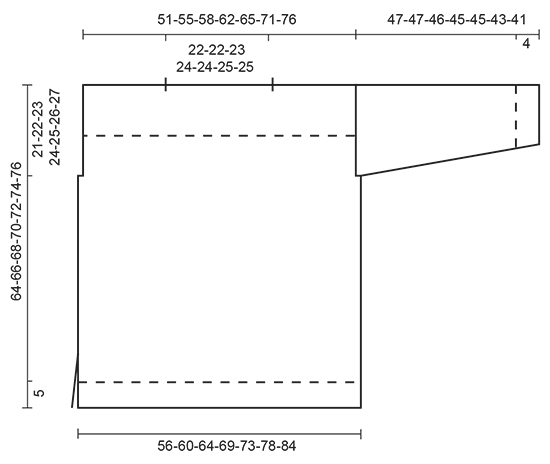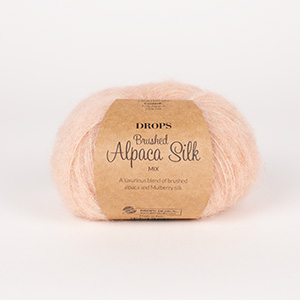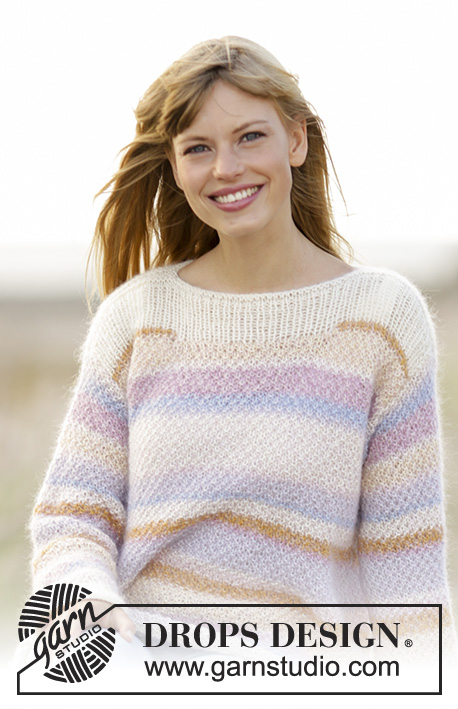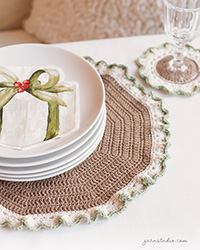Comments / Questions (47)
![]() Christine wrote:
Christine wrote:
Bonjour, Merci beaucoup pour votre réponse. J'ai finalement compris ! Bonne journée.
22.06.2018 - 09:13
![]() Christine wrote:
Christine wrote:
Merci pour votre réponse. Mais j'ai toujours un problème malgré vos explications. Après avoir monté les mailles, je suis sur l'envers du travail (avec boucles) . Vous demandez de tricoter ce rang sur l'endroit en jersey envers alors que je suis sur l'envers. Comment faire ?
21.06.2018 - 17:29DROPS Design answered:
Bonjour Christine, tout à fait, en fonction des modèles et du résultat souhaité le 1er rang va se tricoter soit en mailles envers soit en mailles endroit et sera, soit l'endroit, soit l'envers. Bon tricot!
22.06.2018 - 07:42
![]() Christine wrote:
Christine wrote:
Bonjour, Je tricote le dos et J'ai monté les 82 m. (M). Vous demandez de tricoter un rang à l'envers sur l'endroit du travail mais je suis sur l'envers du travail. Comment doit on tricoter le rang qui suit le montage de mailles ? Merci beaucoup pour votre aide.
20.06.2018 - 20:18DROPS Design answered:
Bonjour Christine, dans ce modèle, le 1er rang après avoir monté les mailles se tricote sur l'endroit, mais en jersey envers puis on continue les côtes en tricotant le 1er rang des côtes sur l'envers. Quand on tricote les rayures, le 1er rang se tricote toujours sur l'endroit. À la fin, le pull sera assemblé avec la partie jersey endroit sur l'envers. Bon tricot!
21.06.2018 - 07:58
![]() Marisa wrote:
Marisa wrote:
Hello, This may be obvious but please confirm, the pattern is worked in garter stitch so I knit every row. However the increase tip says to purl the increase twisted on the following row. Should this read as knit twisted or do I indeed pearl the y.o on following row? Many thanks for your explanation.
12.10.2017 - 22:54DROPS Design answered:
Dear Marisa, this jumper is worked in stocking stitch, ie K from RS and P from WS but when sewing you will turn jumper and sleeves with P side outside (= reverse stocking stitch). Increase-tip is therefore correct. Happy knitting!
13.10.2017 - 09:36
![]() Karoline wrote:
Karoline wrote:
Hei, Hvor finner jeg hvor mye garn jeg trenger til de ulike størrelsene?
24.03.2017 - 14:17DROPS Design answered:
Garnmengden finnes til høyre eller under bildet av modellen, avhengig av hva du leser på. PC, nettbrett eller mobiltelefon.
25.09.2017 - 11:46
![]() Marion Heeren wrote:
Marion Heeren wrote:
Ik maak de trui in xxl, maar blijk ook echt veel te weinig van nr 14 lichtgrijsgroen te hebben. Van alle andere kleuren heb ik meer dan voldoende. Als ik het aantal cm tel dat ik bij het achterpand met lichtgrijsgroen brei komt in de buurt van wat ik met naturel ook brei. Echter van naturel heb ik 125 gram en van lichtgrijsgroen maar 50cm. Erg vervelend nu want ik moet maar hopen dat ik nog aan hetzelfde verfbad kan komen. Misschien is er een aanpassing nodig.
27.02.2017 - 07:54DROPS Design answered:
Hoi Marion. Wij zullen het noteren, onze Design afdeling bekijken het patroon en maken een aanpassing als zij vinden dat het verkeerd is.
27.02.2017 - 14:40
![]() Sharon Brobst wrote:
Sharon Brobst wrote:
Thank you for responding; I did keep my tension per the gauge listed; perhaps the pattern should be updated to state 50 grams, not 25 for this color; I'm not sure what else it could be. Any further thoughts from you would be appreciated. Thanks, Sharon
28.12.2016 - 02:58
![]() Sharon Brobst wrote:
Sharon Brobst wrote:
I ordered the amount of yarn specified in the pattern; my gauge is accurate but I've run out of lavender #17 (substituted for light gray green) and I still have 1 3/4th sleeves to go. Is there anything you could do to assist with this, or at least explain why this might happen? Thanks! Sharon
20.12.2016 - 22:49DROPS Design answered:
Dear Mrs Brobst, did you kept the correct tension when working? You should need 25-50 g light grey green, ie 1-2 balls depending on your size. Happy knitting!
21.12.2016 - 09:39
![]() Esmee wrote:
Esmee wrote:
Het is mij niet duidelijk hoe de ribbelsteek aan de goede kant eruit komt. Anderen hebben deze vraag ook al gesteld, maar die twee antwoorden spraken elkaar weer tegen. Is de tweede pen die je breit (dus aan de verkeerde kant) 1x recht en 2x averecht of 1x averecht en 2x recht?
05.09.2016 - 17:37DROPS Design answered:
Hoi Esmee. Je breit 1 r/ 2 av op de verkeerde kant, dus dat is 1 av/2 r op de goede kant. Zie ook foto.
06.09.2016 - 13:37
![]() RF Mullane wrote:
RF Mullane wrote:
I would like to make DROPS 169-9 (No Worries, pattern no as-054), but would prefer using DROPS Cloud yarn. Based on the # of grams indicated on pattern, I would only need 7-50 g balls of Cloud yarn. However, if I base it on the 325 g of Brushed Alpaca Silk yardage, (1820 m), I would need 22.75-50 g balls of Cloud yarn. Is this correct? Please advise.
11.08.2016 - 19:51DROPS Design answered:
Dear Mrs Mullane, you will fin here how to calculate new amount of yarn when choosing an alternative, and remember your DROPS store will help you also if needed. Happy knitting!
15.08.2016 - 10:25
No Worries#noworriessweater |
|
|
|
|
Knitted DROPS jumper with stripes, rib and vents in 2 strands ”Brushed Alpaca Silk”. Size: XS - XXXL.
DROPS 169-9 |
|
|
GARTER ST (back and forth): K all rows. 1 ridge = K2 rows. STRIPES: Adjust so that last row in every stripe is from WS, i.e. first row in every stripe is from RS. Work stripes with 2 strands as follows: Stripe 1: 1 cm / ⅜" with coral and light sea green Stripe 2: 4 cm / 1½" with off white and light sea green Stripe 3: 4-4-5-5-6-6-7 cm / 1½"-1½"-2"-2"-2½"-2½"-2¾" with light sea green and light gray green Stripe 4: 2 ridges with 2 strands denim blue Stripe 5: 4-4-5-5-4-6-7 cm / 1½"-1½"-2"-2"-1½"-2⅜"-2¾" with light gray green and off white Stripe 6: 3 cm / 1" with light gray green and heather Stripe 7: 5-5-6-6-7-7-7 cm / 2"-2"-2⅜"-2⅜"-2¾"-2¾"-2¾" with light sea green and denim blue Stripe 8: 4 cm / 1½" with light gray green and off white Stripe 9: 2½ cm / ⅞" with light gray green and light beige Stripe 10: 1 cm / ⅜" with heather and light beige Stripe 11: 2½ cm / ⅞" with heather and coral Stripe 12: 1 cm / ⅜" with light sea green and light beige Stripe 13: 2 cm / ¾" with light gray green and off white Stripe 14: 4 cm / 1½" with coral and off white Stripe 15: 4-4-5-5-6-6-6 cm / 1½"-1½"-2"-2"-2⅜"-2⅜"-2⅜" with light beige and off white Stripe 16: 4 cm / 1½" with light beige and light sea green Stripe 17: 1 cm / ⅜" with light gray green and denim blue Stripe 18: 3 cm / 1" with light gray green and off white Stripe 19: Work the rest of the jumper in off white and light sea green. INCREASE TIP: Always inc from RS. Inc 1 st by making 1 YO, on next row P YO twisted to avoid holes. ---------------------------------------------------------- JUMPER: Worked back and forth on circular needle to make room for all the sts. Jumper is worked in stockinette st but sewn tog with WS outwards. BACK PIECE: Cast on 73-76-82-88-94-100-106 sts on circular needle size 6 mm / US 10 with 1 strand coral and 1 strand light sea green. P 1 row from RS. Then work in STRIPES - see explanation above - as follows from WS: Work 3 sts in GARTER ST - see explanation above - rib = K 1/P 2 until 4 sts remain, K 1, finish with 3 sts in garter st. When 2nd stripe has been worked, switch to circular needle size 8 mm / US 11. Work in stockinette st with 3 sts in garter st in each side of piece and dec 11-10-12-12-14-14-14 sts evenly on first row = 62-66-70-76-80-86-92 sts. When piece measures 15 cm / 6", cast on 1 edge st in each side of piece at the end of the next 2 rows = 64-68-72-78-82-88-94 sts. Work in stockinette st with 1 edge st in garter st in each side of piece. REMEMBER THE KNITTING GAUGE When piece measures 43-44-45-46-47-48-49 cm / 17"-17¼"-17¾"-18"-18½"-19"-19¼", bind off 4-4-4-5-5-5-5 sts for armhole at beg of the next 2 rows = 56-60-64-68-72-78-84 sts. When 18th stripe has been worked (piece measures 52-52-56-56-58-60-62 cm / 20½"-20½"-22"-22"-22¾"-23½"-24½" adjust so that last row is from WS, work 19th stripe and inc 11-10-12-11-13-13-13 sts evenly on first row = 67-70-76-79-85-91-97 sts. Switch to circular needle size 6 mm / US 10. On next row from WS work as follows: Work rib = K 1/P 2, finish with K 1. Continue with K over K and P over P until piece measures 64-66-68-70-72-74-76 cm / 25¼"-26"-26¾"-27½"-28⅜"-29⅛"-30". Insert 1 marker after 20-21-23-24-27-29-32 sts in from each side (marks shoulder seams). Bind off sts with K over K and P over P on circular needle size 8 mm / US 11. FRONT PIECE: Cast on and work as back piece. SLEEVE: Worked back and forth on needle. Cast on 29-29-32-32-35-35-35 sts on circular needle size 6 mm / US 10 with 1 strand off white and 1 strand light sea green. P 1 row from RS. Then work as follows from WS: Work rib K 1/P 2 with 1 edge st in garter st in each side of piece. When piece measures 4 cm / 1½", P from WS and dec 3-3-4-4-5-5-5 sts evenly = 26-26-28-28-30-30-30 sts. Switch to circular needle size 8 mm / US 11. Work in stockinette st with 1 edge st in garter st in each side and work 3rd-13th stripe. When piece measures 8 cm / 3⅛", inc 1 st inside 1 edge st in garter st in each side of piece - READ INCREASE TIP! Repeat inc every 3½-3-3-2½-2½-2-2 cm / 1¼"-1⅛"-1⅛"-⅞"-⅞"-¾"-¾" 10-11-11-12-12-14-15 more times = 48-50-52-54-56-60-62 sts. When 3rd-13th stripe has been worked 1 time, finish piece with 1 strand light sea green and 1 strand off white. Bind off when piece measures 47-47-46-45-45-43-41 cm / 18½"-18½"-18"-17¾"-17¾"-17"-16" (shorter measurements in the larger sizes because of wider shoulders). Make another sleeve. ASSEMBLY: Sew jumper tog with WS outwards. Sew shoulder seams in to markers. Sew in sleeves with WS outwards, sew sleeve seams inside 1 edge st, sew side seam inside 1 edge st down to the 3 sts in garter st in each side (= approx. 15 cm / 6" vent). |
|
 |
|
Have you finished this pattern?Tag your pictures with #dropspattern #noworriessweater or submit them to the #dropsfan gallery. Do you need help with this pattern?You'll find 17 tutorial videos, a Comments/Questions area and more by visiting the pattern on garnstudio.com. © 1982-2025 DROPS Design A/S. We reserve all rights. This document, including all its sub-sections, has copyrights. Read more about what you can do with our patterns at the bottom of each pattern on our site. |
























































Post a comment to pattern DROPS 169-9
We would love to hear what you have to say about this pattern!
If you want to leave a question, please make sure you select the correct category in the form below, to speed up the answering process. Required fields are marked *.